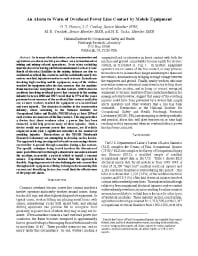Mining Publication: An Alarm to Warn of Overhead Power Line Contact by Mobile Equipment
Original creation date: September 2001
Authors: GT Homce, JC Cawley, MR Yenchek, HK Sacks
NIOSHTIC2 Number: 20021334
Conference Record of the 2001 IEEE Industry Applications Conference, 36th IAS Annual Meeting (Chicago, Illinois, September 30-October 4, 2001); :8 pp
As in many other industries, such as construction and agriculture, overhead electric powerlines are a serious hazard at mining and mining-related operations. Even when excluding injuries that occur during electrical maintenance work, over one fourth of electrical fatalities in the mining industry are due to accidental overhead line contacts, and for each fatality nearly two serious non-fatal injuries occur due to such contacts. In incidents involving high-reaching mobile equipment, many of the victims touched the equipment after the fact, unaware that the machine frame had become energized by the line contact. MSHA data for accidents involving overhead power line contacts in the mining industry between 1980 and 1997 reveal that in 57 percent of the cases personnel were unaware of the accidental line contact until after one or more workers touched the equipment or a hoisted load and were injured, The situation is similar in the construction industry, where according to the National Institute for Occupational Safety and Health (NIOSH) data at least 20 percent of such victims are unaware of the line contact. This suggests that a device that alerts workers when a power line has been contacted could help prevent many of these injuries. Such a device would not prevent power line contacts, yet if widely employed could yield a significant reduction in the number of resulting injuries. Researchers at the NIOSH Pittsburgh Research Laboratory are attempting to develop such a device. The approach being investigated is based on measuring electric current flow to ground through a machine during a line contact. The specific technique being tested involves the diversion of some part of this current through a shunt cable mounted on board the machine, to provide a point at which to install a current sensor. Experiments thus far indicate that this approach is feasible. Ongoing research is better defining electric current flow through mobile equipment, refining techniques for measuring this current, and identifying factors that could limit the effectiveness of the proposed alarm.

NIOSHTIC2 Number: 20021334
Conference Record of the 2001 IEEE Industry Applications Conference, 36th IAS Annual Meeting (Chicago, Illinois, September 30-October 4, 2001); :8 pp
- Electric Shock Prevention
- Electrical Accidents in the Mining Industry, 1990-1999
- Electromagnetic Noise in Robena No. 4 Coal Mine
- Heavy Equipment Near Overhead Power Lines? New Safety Research May Save Your Life: New Safety Research May Save Your Life
- Look Up, Look Down, Look Out
- Mine Power Systems
- Noise Exposure and Overhead Power Line (OPL) Safety Hazards at Surface Drilling Sites
- Occupational Electrical Injuries in the United States, 1992-1998, and Recommendations for Safety Research
- A Performance Evaluation of Two Overhead Power Line Proximity Warning Devices
- U.S. Bureau of Mines/NIOSH Mining Electrical Safety Research: A Legacy of Protection Against Shock, Fires, and Explosions